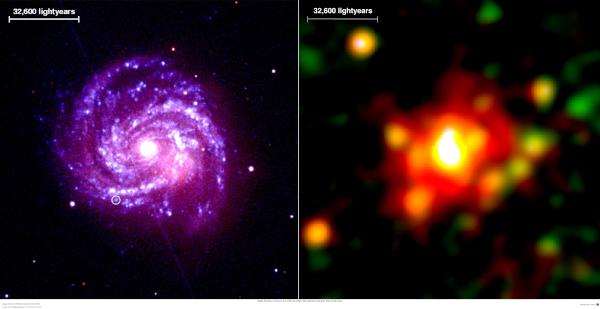XMM-Newton's Views of SN 1979C in M100: The supernova that just won't fade away

Minimum credit line: Image courtesy of Stefan Immler (NASA GSFC) and ESA. (for details, see Conditions of Use).
Credit: ESA/XMM-Newton, CC BY-SA 3.0 IGO
The image above can be displayed at full size and may be downloaded by clicking the image above.
| About this Image |
|---|
These false-colour images show the spiral galaxy M100, also known as NGC 4321, and within the galaxy the supernova SN 1979C. On the left is the image of M100 in the UV/optical, taken with XMM-Newton's Optical Monitor (OM) camera, and on the right the galaxy is shown on the same scale but imaged in the X-ray with XMM-Newton's MOS cameras. M100 is in the Virgo cluster of galaxies, 56 million light years from Earth. The overall appearance of the galaxy is strikingly different in the X-ray compared to the UV/optical. The OM image clearly shows the spiral structure of the galaxy whilst in the X-ray image this structure is not visible and instead the galaxy X-ray luminosity tends to fall off from the galaxy centre, with some bright regions. The supernova 1979C is shown circled in the UV/optical image, and can be seen as an orange spot to the lower left of the galactic centre (which appears white) in the X-ray image. This particular supernova is curious because it is still just as bright in the X-ray as when it was observed by ROSAT in 1995, six years before the XMM-Newton observation. Normally objects of this type would be expected to dim significantly over time. In the OM image the false colouring was done using images taken with three fiters: the B filter (4340 Å), the U filter (3440 Å) and the UVW1 (2910 Å). In the X-ray image soft (0.3-1.5 keV) X-rays are shown in red, medium (1.5-4 keV) in green and hard (4-10 keV) in blue. The hardest X-rays are emitted from the galactic core, but are not seen as pure blue because there are also medium and soft X-rays emitted from that location.
Investigator(s): S. Immler, R. A. Fesen, S. D. Van Dyk, K. W. Weiler, R. Petre, W. H. G. Lewin, D. Pooley, W. Pietsch, B. Aschenbach, M. C. Hammell, G. C. Rudie
| For More Information |
|---|
- Read the Press Release
- Read the Journal article
- Detailed description of this image
- Query XSA archive for XMM-Newton data in the field of SN 1979C
- Astronomical database entries for SN 1979C;
- Query NED for more images about SN 1979C
- Query SIMBAD for more SN 1979C data
- For unfamiliar terms, visit the XMM-Newton Astronomical Glossary
| Alternate Resolutions | (Help) |
|---|
This image is available in the following downloadable versions: Higher resolution versions of this image may be available, please contact the XMM-Newton HelpDesk.
Search the Image Gallery
To search the Image Gallery for a particular object, fill in the object name in the box below and click the Submit button.To search the Image Gallery for other images, fill in any of the fields below and click the Submit button.
For more search options, please use our Advanced Search form.